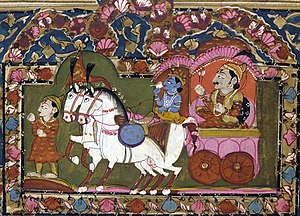Ratha
chariot
Ratha (Proto-Indo-Iranian: *Hrátʰas, Sanskrit: रथ, rátha, Avestan: raθa) is the Indo-Iranian term for a spoked-wheel chariot or a cart of antiquity.

Quotes
edit- The twelve-spoke wheel of truth revolves about the heaven unwearied. Seven hundred and twenty sons in pairs stand on it, O Agni. They call the full one in the upper half of heaven the “Father with five feet and twelve forms”. These others call him “the far-seeing one mounted below on seven wheels and six spokes”. On this ever-revolving five-spoked wheel, all creatures take their stand. Its axle, though bearing a heavy load, does not get hot, nor has its nave ever broken apart for ages.
- Rigveda,1, 164; quoted in M. Danino, "A Demilitarizing the Rigveda: A Scrutiny of Vedic Horses, Chariots and Warfare", Journal of the Inter-University Centre for Humanities and Social Sciences, vol. 26, no. 1 (Summer 2019)